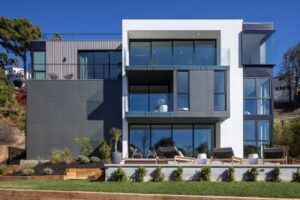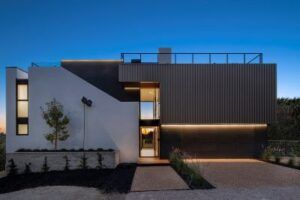Whether or not you believe the number of disastrous weather events are increasing or worsening, you must acknowledge the importance of improving building methods with weather events in mind. From heavy rains and winds in the southeast, heavy snow in the north and wildfires bolstered by heavy winds, Mother Nature has taken a toll on all kinds of buildings in recent months.
METALCON, taking place October 21-23 in Las Vegas, offers educational opportunities for builders, contractors, architects, engineers, installers and roofers, all focused on improving building techniques, material performance and system resilience in the face of increasingly severe weather events.
“Climate change continues to challenge our standards,” says Brian Partyka, Vice President of Development at Carlisle. “Storms are becoming fiercer, droughts create dry conditions leading to national red flag warnings, and we as building product manufacturers want to learn how we can assist architects, community planners, builders, homeowners and code bodies and officials in limiting destruction from these weather-related events. Building to code compliance means contracting the legal minimum standards set by local, state and national authorities.”
Partyka will present, “Stronger Structures, Safer Assets: The Value of Metal in Extreme Weather Zones” during METALCON, addressing everything from fast-moving wildfires to hurricanes. The focus will be on roofing materials, particularly performance ratings under ASTM E108 and UL 790. Partyka’s sessions will explore how metal roofing plays a critical role in protecting structures and communities in the era of climate extremes.
“A great example of code compliance evolution is the wind requirements enforced post-hurricanes in Florida,” Partyka says. “Yes, it took a while, but people have become more educated about the performance of their roofs during a wind event and have made the choice to select the right products for their environment. I call it ‘Code Plus,’ meaning what building product systems and solutions can I invest in to give me peace of mind during storm events? Am I giving my home or building the best chance to survive the event? That’s what we mean by resilience. Through education and awareness, I believe the same will happen. Again, it must be a system-driven, holistic approach, rather than a product-driven one. This approach would also lead to insurance premium reductions.”
Fire test standards focus on flammability, combustibility, ignition-resistance and building envelope composition. Prevention begins with planning, involving the careful combination of noncombustible materials, including metal.
“Fire events are incredibly destructive, typically consuming all if not most of a structure if not mitigated,” says David Carmack, Product Manager at Parallel Architectural Products, a manufacturer and supplier of aluminum systems, created to mimic the aesthetic of a traditional wood panel. “A total loss of property and/or life can be anticipated when using combustible and/or flammable materials. The less ‘fuel’ in a building’s makeup, the more resilient it will be in a fire event. Metals can also increase property values and improve code compliance. The use of noncombustible materials provides better overall coverage of a property with potentially lower insurance premiums.
“The main takeaway here is to prevent fire in the building world, we want to add less ‘fuel to the fire.” Specifying metals and other composites promotes a more resilient structure, reducing overall risk for catastrophe in unexpected events.”
Also, at METALCON, two visionaries will present in the Design District at METALCON, a curated AIA-accredited program for architectural design professionals. Erla Dögg Ingjaldsdóttir and Tryggvi Thorsteinsson, principals and co-founders Minarc in Santa Monica, Calif., will present “Breaking the Cycle of Wildfire Destruction: The Urgent Need for Fire-Resilient Construction.” Ingjaldsdóttir, Assoc. AIA and IIDA and Thorsteinsson, Assoc. AIA, and have seen California wildfire destruction firsthand. Their session is a powerful addition to the Design District’s focus on future architecture and high-performance building.



Bryan Partyka MINARC Portrait David Carmack MINARC Alplce2
Images Courtesy of: METALCON
“The next step isn’t just about changing how we design, but about sparking broader systemic change,” Ingjaldsdóttir says. “As long as current code regulations fail to reflect the true risks of wildfires, we’ll have to continue rebuilding communities with the same vulnerabilities as before. High-rise buildings are required to meet strict safety standards, but homes in wildfire-prone regions still often use flammable materials with minimal oversight. With this in mind, design and construction practices should include the use of nonflammable materials like steel, while embracing passive technology like underground pumps that can reclaim pool or salt water to aid in fire prevention efforts.”
Building homes with fire-resiliency in mind is becoming more important in areas prone to wildfires as well as areas at all vulnerable to wildfires.
“The biggest challenge is a lack of education and widespread understanding across the industry,” Thorsteinsson says. “Contractors are typically the first point of contact for homeowners and they often are not familiar with fire-resilient strategies or view them as an added burden to the process, rather than necessary. A lack of expertise among clients and those building the homes leads to the untrue perception of higher costs, making these strategies seem ever increasingly out of reach. This issue is made worse by the fact that building codes in high-risk areas lag behind their counterparts in more metropolitan areas. “Until codes begin to mandate smarter material choices and construction practices, the average person has little incentive to change.”
Insurance companies have become hesitant to insure homes in wildfire regions and will certainly influence construction practices moving forward. “They’re already starting to play a pivotal role,” Ingjaldsdóttir says. “From their perspective, everything about steel construction, from its longevity to strength and fire resistance, is positive. With claims from wildfire damage rising year after year, they have an incentive to support more resilient construction methods. If entire communities worked together to embrace these strategies and materials, insurance costs could drop dramatically. This would make fire-resilient design not only safer but provide an added economic incentive for the average person.”
Fire-resilient materials simply must be mandated in areas prone to wildfires.
“Metal roofing and wall systems are critically important in terms of protecting structures in fire-prone areas,” Thorsteinsson says. “They’re noncombustible, durable and work to reduce the harmful spread of embers and flames during fire events. When your home or your neighbors doesn’t ignite due to the use of these elements, your entire neighborhood is better off for it. This kind of unity should be central to any rebuilding efforts, not just resilience but for our collective sense of security.
(Partyka is scheduled to speak at noon, Wednesday, October 22; Ingjaldsdóttir and Thorsteinsson are scheduled to speak at 8 a.m., Wednesday, Oct. 22.).
METALCON is the largest international event in the metal construction and design industry. Established in1991, it’s the only annual tradeshow and conference devoted exclusively to the application of metal in design and construction. Each year, contractors, architects, developers, owners, installers, fabricators, manufacturers and suppliers from more than 50 countries attend. 250+ leading companies exhibit the latest products, solutions and game-changing technologies. Produced by PSMJ Resources, Inc., in partnership with the Metal Construction Association, METALCON’s success is based on a dynamic exhibit hall, extensive educational programs and interactive learning opportunities. For information, visit www.metalcon.com or call 800-537-7765.
MCA creates Metal Resilience Council
The Metal Construction Association is forming the Metal Resilience Council to be proactive when it comes to promoting metal construction systems as a leading solution for resilience in the face of “escalating climate-related threats, natural disasters and evolving building performance standards.
The council is aiming to position metal as a leading component of resilient structures, educate end users of metal’s resiliency attributes, develop test standards and best practice guides advancing metal as a resilient material and drive innovation of metal systems.

MINARC ALPLCE2
Feature Image Courtesy of: METALCON
View the original article and our Inspiration here


Leave a Reply